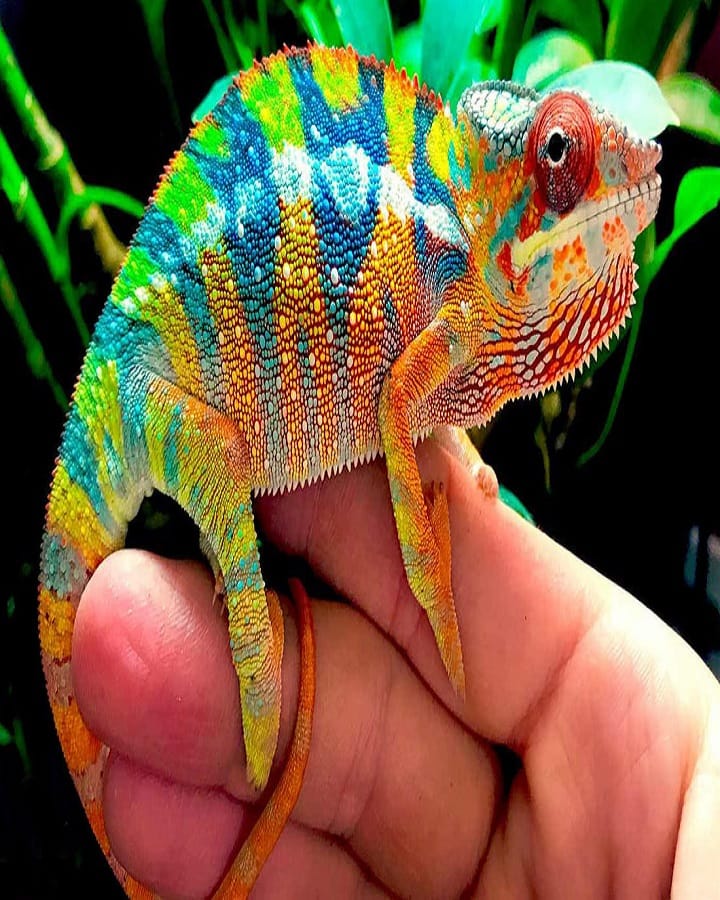
Image Credit – Hema
Among the most captivating creatures in the animal kingdom, the colour chameleon stands out as a true marvel of nature. Known for its extraordinary ability to change skin colour, this reptile has fascinated scientists, animal lovers, and storytellers alike for centuries. Native to warm habitats like Madagascar, Africa, and parts of southern Europe, chameleons are not just masters of disguise but also important indicators of environmental health. Their colour-shifting ability is more than just camouflage—it is a complex tool for communication, temperature regulation, and survival.
The Fascinating World of the Colour Chameleon

What Makes Chameleons Unique?
Unlike other reptiles, chameleons have a distinctive appearance. Their independently rotating eyes can move in two different directions at once, giving them a 360-degree view of their surroundings. Their long, sticky tongues can shoot out with lightning speed to catch insects, making them highly efficient hunters. But the most fascinating feature remains their colour-changing skin, which can shift from subtle greens and browns to vibrant shades of red, yellow, blue, and even purple.
Why Do Chameleons Change Colour?
Most people assume chameleons change colour simply to blend into their environment. While camouflage is certainly one reason, it is far from the only one. Chameleons shift shades for several purposes:
- Communication – Male chameleons often display bold colours to attract females or to warn rival males. Bright, aggressive shades like red or orange signal dominance, while subdued tones may indicate submission.
- Temperature Regulation – Because chameleons are cold-blooded, they rely on external heat to regulate body temperature. Darker colours absorb heat, helping them warm up in cooler weather, while lighter shades reflect sunlight, keeping them cool.
- Mood and Stress – A stressed or threatened chameleon might turn darker, while a relaxed one often shows softer, natural hues.
- Camouflage – Of course, blending into their surroundings is still crucial for survival, helping them avoid predators like snakes and birds.
The Science Behind Colour Changes
Chameleons’ colour transformation is made possible by specialized skin cells called chromatophores and iridophores. Chromatophores contain pigments of different colours, while iridophores reflect light using tiny crystals. By expanding or contracting these cells, chameleons can manipulate the way light bounces off their skin, creating a spectacular range of colours and patterns. This biological process is an elegant mix of art and science—nature’s very own colour palette.
Symbol of Adaptability
The colour chameleon has become a symbol of adaptability and versatility in human culture. Just as the chameleon changes its colours to adjust to its environment, people use the term “chameleon” metaphorically to describe someone who easily adapts to new situations. This symbolism is often celebrated in literature, art, and even fashion, where colour-changing designs mimic the magic of chameleon skin.
Importance in Ecosystems
Chameleons play a vital role in maintaining balance within ecosystems. As insectivores, they help control insect populations, preventing outbreaks that could harm plants and crops. Their presence indicates a healthy environment, as they thrive in habitats with rich biodiversity. Sadly, due to deforestation, climate change, and the illegal pet trade, many species of chameleons are now threatened. Protecting them means preserving entire ecosystems.
Human Fascination with Colour Chameleons
From children’s books to scientific studies, the colour-changing ability of chameleons has always sparked human curiosity. Researchers continue to study these reptiles to unlock new discoveries about light manipulation, which may inspire innovations in fields like nanotechnology, camouflage materials, and even medical imaging. Meanwhile, their beauty makes them popular in art, photography, and wildlife tourism.
How We Can Protect Them
Protecting chameleons begins with conserving their natural habitats. Deforestation for agriculture and urban expansion threatens their survival. Supporting wildlife conservation programs, discouraging illegal pet trade, and raising awareness are critical steps toward safeguarding these unique creatures. If you ever encounter a chameleon in the wild, the best way to appreciate it is to observe without disturbing.
The colour chameleon is more than just a reptile with the magical ability to change colours—it is a symbol of resilience, adaptability, and the wonders of nature’s design. Its shifting shades tell stories of survival, emotion, and communication that go far beyond simple camouflage. As we admire this fascinating creature, it also reminds us of our responsibility to protect the delicate ecosystems that sustain life on Earth.
So, the next time you hear about a colour chameleon, remember that it’s not just about the colours—it’s about the lessons they teach us about change, balance, and harmony with the natural world.
Frequently Asked Questions
Are colour chameleons endangered?
Some species of chameleons are indeed endangered due to habitat destruction, climate change, and illegal pet trade. Protecting their natural environment, supporting conservation programs, and discouraging the capture of wild chameleons for pets are essential to ensuring their survival.
How does a colour chameleon change its skin colour?
A colour chameleon’s skin contains special cells called chromatophores and iridophores. Chromatophores hold pigments, while iridophores reflect light with microscopic crystals. By expanding or contracting these cells, chameleons create stunning colour changes ranging from greens and browns to bright reds, yellows, and blues.
Why do colour chameleons change their colours?
Chameleons change their colours for multiple reasons beyond camouflage. They shift shades to regulate body temperature, communicate with other chameleons, and express their mood or stress levels. For example, darker colours help them warm up in cool weather, while brighter shades can signal aggression or attract mates.







